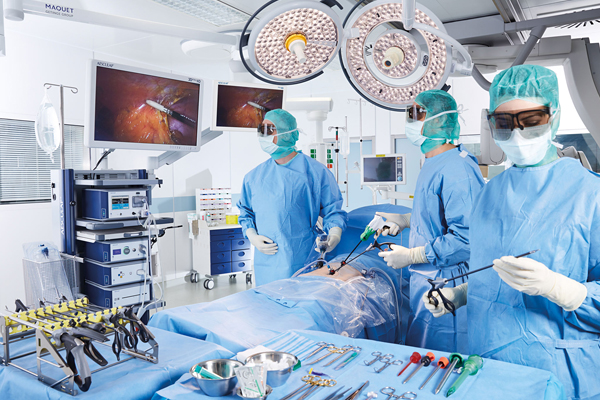Laparoscopy in Pakistan
Search and Compare the Best Clinics and Doctors at the Lowest Prices for Laparoscopy in Pakistan

Find the best clinics for Laparoscopy in Pakistan
No clinics available
Germany offers the best prices Worldwide
Price: $ 586

- Home
- Pakistan
WHY US?
At Medijump, we're making medical easy. You can search, compare, discuss, and book your medical all in one place. We open the door to the best medical providers worldwide, saving you time and energy along the way, and it's all for FREE, no hidden fees, and no price markups guaranteed. So what are you waiting for?

Free

Best Price

Widest Selection

Risk-Free
What you need to know about Laparoscopy in Pakistan

Laparoscopy is a type of surgery that allows surgeons to access the inside of the abdomen and pelvis with only small incisions. Also known as minimally invasive or keyhole surgery, laparoscopy is less painful than traditional open surgery. Other benefits of this type of surgery include less bleeding, reduced scarring, and a faster recovery period.
What does a Laparoscopy Procedure Involve?
Laparoscopy is performed under general anesthetic. During the surgery, your surgeon makes small incisions in your abdomen to insert an instrument called a laparoscope, small surgical tools, as well as a tube to pump gas into the abdomen. A laparoscope is a small tube with a camera and a light attached to its end and the camera sends images of the inside of the abdomen to a monitor.
How Long Should I Stay in Pakistan for a Laparoscopy Procedure?
You may be able to go back to your hotel immediately after a laparoscopy, but in some cases, you may need to stay for at least 1 to 2 days. You may be able to fly back home within 3 to 7 days after the surgery. During your stay, you will have to attend hospital check-ups and to rest.
What's the Recovery Time for Laparoscopy Procedures in Pakistan?
The recovery period for laparoscopic surgery depends on the type of treatment. However, the overall recovery period is shorter than the traditional surgery. For example, the total recovery period for intestinal surgery with traditional methods may take 4 to 8 weeks, but with laparoscopic surgery, you only need 2 to 3 weeks to recover and return to work.
What sort of Aftercare is Required for Laparoscopy Procedures in Pakistan?
The aftercare will be different from one person to another, depending on what type of condition the surgery is used for. Your surgeon will tell you how to keep your wounds clean, the diet you will need to follow, and the type of exercise you can do. You will likely have a follow-up check-up with your local doctor to monitor your condition.
What's the Success Rate of Laparoscopy Procedures in Pakistan?
Laparoscopy is known to have a high success rate. Serious side effects, risks, and complications are rare. Minor complications occur in 1 out of every 100 cases, while serious complications occur in 1 out of every 1,000 cases. The side effects and risks include infection, minor bleeding, damage to an organ, or damage to a major artery.
Are there Alternatives to Laparoscopy Procedures in Pakistan?
Laparoscopic surgery is an alternative to traditional open surgery. You can always undergo open surgery if you prefer to do so. There are also some treatment alternatives to laparoscopic surgery, but this depends on the condition you want to treat.
What Should You Expect Before and After the Procedure
Before a laparoscopy, you may have problems in your appendix, kidney, or other parts of your abdomen. After the surgery, these issues are treated and possibly resolved.
Whilst the information presented here has been accurately sourced and verified by a medical professional for its accuracy, it is still advised to consult with your doctor before pursuing a medical treatment at one of the listed medical providers
No Time?
Tell us what you're looking for and we'll reachout to the top clinics all at once
Enquire Now

Popular Procedures in Pakistan
Prices Start From $520

Recommended Medical Centers in Pakistan for procedures similar to Laparoscopy

- Interpreter services
- Translation service
- Religious facilities
- Medical records transfer
- Medical travel insurance
- Health insurance coordination
- TV in the room
- Safe in the room
- Phone in the room
- Private rooms for patients available

- Interpreter services
- Translation service
- Religious facilities
- Medical records transfer
- Medical travel insurance
- Health insurance coordination
- TV in the room
- Safe in the room
- Phone in the room
- Private rooms for patients available

- Interpreter services
- Translation service
- Religious facilities
- Medical records transfer
- Medical travel insurance
- Health insurance coordination
- TV in the room
- Safe in the room
- Phone in the room
- Private rooms for patients available

- Interpreter services
- Translation service
- Religious facilities
- Medical records transfer
- Medical travel insurance
- Health insurance coordination
- TV in the room
- Safe in the room
- Phone in the room
- Private rooms for patients available

- Interpreter services
- Translation service
- Religious facilities
- Medical records transfer
- Medical travel insurance
- Health insurance coordination
- TV in the room
- Safe in the room
- Phone in the room
- Private rooms for patients available

- Interpreter services
- Translation service
- Religious facilities
- Medical records transfer
- Medical travel insurance
- Health insurance coordination
- TV in the room
- Safe in the room
- Phone in the room
- Private rooms for patients available

- Interpreter services
- Translation service
- Religious facilities
- Medical records transfer
- Medical travel insurance
- Health insurance coordination
- TV in the room
- Safe in the room
- Phone in the room
- Private rooms for patients available

- Interpreter services
- Translation service
- Religious facilities
- Medical records transfer
- Medical travel insurance
- Health insurance coordination
- TV in the room
- Safe in the room
- Phone in the room
- Private rooms for patients available

- Interpreter services
- Translation service
- Religious facilities
- Medical records transfer
- Medical travel insurance
- Health insurance coordination
- TV in the room
- Safe in the room
- Phone in the room
- Private rooms for patients available

- Interpreter services
- Translation service
- Religious facilities
- Medical records transfer
- Medical travel insurance
- Health insurance coordination
- TV in the room
- Safe in the room
- Phone in the room
- Private rooms for patients available
Laparoscopy in and around Pakistan
Introduction
The Islamic Republic of Pakistan is a country located in South Asia and it is the fifth-most populous country of the world, with a population exceeding 207.8 million. Although the country has plenty of natural and historical riches, this country is off the radar for most tourists due to political instability. Those who are curious enough to visit the country will find that it is filled with beautiful, from Mughals and mountains to the mighty Karakoram.
A large number of ultra-modern medical centers are available, and they are equipped and facilitated with the most advanced medical technologies. Numerous doctors and surgeons at these medical centers are normally foreign qualified. Large numbers of patients from neighboring countries and the Middle East have traveled to Pakistan to undergo various medical procedures, mainly for organ transplants or fertility treatments.
Popular Cities and Regions in Pakistan
The capital city of Pakistan is Islamabad. This city was built as a planned city to replace Karachi as the country’s capital. Islamabad is known for its safety, high standards of living, and plenty of green spaces. Here, tourists can admire the symmetry of the Pakistan Monument, check out the Daman-e-Koh viewpoint, visit the Lok Virsa Museum, and stroll around the Faisal Mosque. Karachi, the original capital of the country, is a sprawling metropolis. Most visitors usually come to check out the Quaid Mausoleum and the Tuba Mosque. Another popular city for tourism in Lahore, which is filled with beautiful architecture and interesting museums. The most popular attractions in this city are the Badshahi Mosque, the Lahore Fort, the Sheesh Mahal, and the Delhi Gate.
Transport in Pakistan
The busiest airport in Pakistan is the Jinnah International Airport, which is located in Karachi. It serves both domestic and international flights to and from several cities in Europe, Asia, and the Middle East. Taking domestic flights can be a great way to travel around. The rail network is also extensive and comfortable. Taxis and Uber are also available.
Visas in Pakistan
Citizens of 5 countries, including Maldives, Nepal, Samoa, Tonga, and Trinidad and Tobago, can visit Pakistan without a visa. Several countries, such as Austria and the UAE, may obtain a visa on arrival if they possess ETA. Citizens of 15 countries, including Armenia and India, are eligible to apply for an online visa.
Weather in Pakistan
Summer (March – October) is hot and dry in the northern regions. However, July and August can be rainy, making the weather hot and humid. The temperatures can range from 9°C to 38°C. Winter (November – April) can be really severe and most cities will get frost. Also, the northern part of the country experiences heavy rainfall during this season. The average temperature ranges from 3°C to 25°C.
Additional Info
- Local Currency: The official currency is the Pakistani rupee (PKR). 1 USD will get you approx. 154.4 PKR.
- Money & Payments: ATMs are readily available. Pakistan is a cash-based society, and credit cards are only accepted in a few establishments. Tipping is not expected.
- Local Language: The official language is Urdu and English. Punjabi, Pashto, Sindhi, Saraiki, and Balochi are also spoken by a number of people.
- Local Culture and Religion: Islam is practiced by more than 90% of the population. Hinduism, Christianity, Ahmadis, Sikhism, and other religions are also practiced. Always avoid wearing body-revealing clothes in public places.
- Public holidays: Some of the most celebrated holidays are Holi, Pakistan Day, Eid ul-Fitr, and Eid ul-Azha.
Popular Searches
- Plastic Surgery in Thailand
- Dental Implants in Thailand
- Hair Transplant in Thailand
- Breast Augmentation Thailand
- Gastric Sleeve in Thailand
- Gender Reassignment Surgery in Thailand
- Laser Hair Removal in Bangkok
- Botox in Bangkok
- Dermatology in Bangkok
- Breast Augmentation in Bangkok
- Coolsculpting in Bangkok
- Veneers in Turkey
- Hair Transplant in Turkey
- Rhinoplasty in Turkey
- Stem Cell Therapy in Mexico
- Rhinoplasty in Mexico
- Liposuction in Mexico
- Coolsculpting in Tijuana
- Rhinoplasty in Korea
- Scar Removal in Korea
- Gastric Sleeve in Turkey
- Bone Marrow Transplant in India
- Invisalign in Malaysia
- Plastic Surgery in the Dominican Republic
- Tummy Tuck in the Dominican Republic
- Plastic and Cosmetic Surgery in Poland
- Rhinoplasty in Poland
- Hair Implant in Poland
- Dental Implants in Poland
- IVF in Turkey